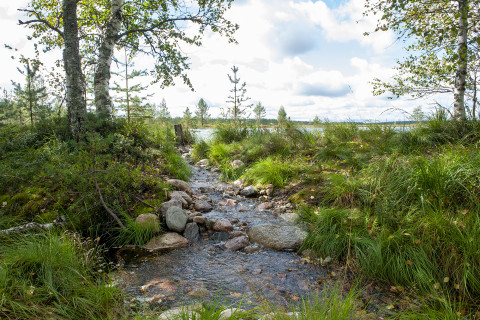Scientists have unearthed and pieced together evidence on more than 1,000 ancient wetland sites from across the globe, that are presently covered by fields, forests and lakes. Although vanished from the Earth’s surface, these buried sites could explain some of the differences between global carbon cycle models and real-life observations.
Cliffs, quarries, road construction, and scientific sampling have revealed carbon-rich wetland deposits buried under other kinds of soils and sediments. Many wetlands are characterized by thick deposits of undecomposed plant material (or peat), which is often preserved, resulting in a record of wetland presence. The buried wetlands frequently included coastal marshes that had been flooded by sea level rise, and wetlands that had been buried by glaciers, flooding, or wind-deposited sediments.
The researchers compiled the information about these buried wetland deposits, including where they were found, when they formed, and why they were buried.
“We were really surprised when we started to combine our data from different sites around the world. What we thought would be only a few sites turned out to be just the tip of the iceberg. When we started to look for more examples from previous studies, we identified more than 1,000 buried wetland sites across the globe,” Dr Claire Treat from the University of Eastern Finland says.
The study was led by Dr Treat at the University of Eastern Finland and by Dr Thomas Kleinen at the Max Planck Institute for Meteorology in Germany.
Buried wetland sites were found from high Arctic islands of Canada and Siberia to tropical Africa and Indonesia, to Southern South America and New Zealand. Some formed less than 1,000 years ago, while others formed during the warm climate period between the two latest glaciations more than 100,000 years ago.
Using these records of wetland presence since the beginning of the last interglacial, 130,000 years ago, the researchers found that wetlands in northern latitudes responded to changes in climate. Wetlands formed when the climate was warmer, and many wetlands were buried during periods of glacial advance and cooling temperatures. When it was cold, few new wetlands formed until the climate warmed again. Some of these buried peat sediments remain until today. These new findings of widespread buried peats suggest that, on the whole, peat burial can result in the slow transfer of carbon from the atmosphere to land, ultimately offsetting a small part of climate warming in the past.
“The fact that these peats are buried and stay on land is basically like a leak in what we usually consider a closed system of how carbon moves around the earth, from the atmosphere to the land and oceans. This new finding isn’t represented in our models of the global carbon cycle, and may help to explain some behaviour that differs between models and observations,” Dr Treat from the University of Eastern Finland says.
The results also suggest that present-day wetlands may continue to offset rising atmospheric CO2 concentrations as the climate warms if they remain undisturbed by drainage and wildfires.
For further information, please contact:
Dr Claire Treat (Postdoctoral Researcher), University of Eastern Finland, [email protected] (English)
Dr Thomas Kleinen (Research Scientist), Max Planck Institute for Meteorology, Hamburg, Germany [email protected] (English, German)
Research article:
Treat, C.C., T. Kleinen, N. Broothaerts, A.S. Dalton, R. Dommain, T.A. Douglas, J. Drexler, S.A. Finkelstein, G. Grosse, G. Hope, J. Hutchings, M.C. Jones, P. Kuhry, T. Lacourse, O. Lähteenoja, J. Loisel, B. Notebaert, R. Payne, D. Peteet, A.B.K. Sannel, J.M. Stelling, J. Strauss, G.T. Swindles, J. Talbot, C. Tarnocai, G. Verstraeten, C.J. Williams, Z. Xia, Z. Yu, M. Väliranta, H. Alexanderson, M. Hattestrand, V. Brovkin. Widespread global peatland establishment and persistence over the last 130,000 years. Proc. Proceedings of the National Academy of Science. 10.1073/pnas.1813305116


